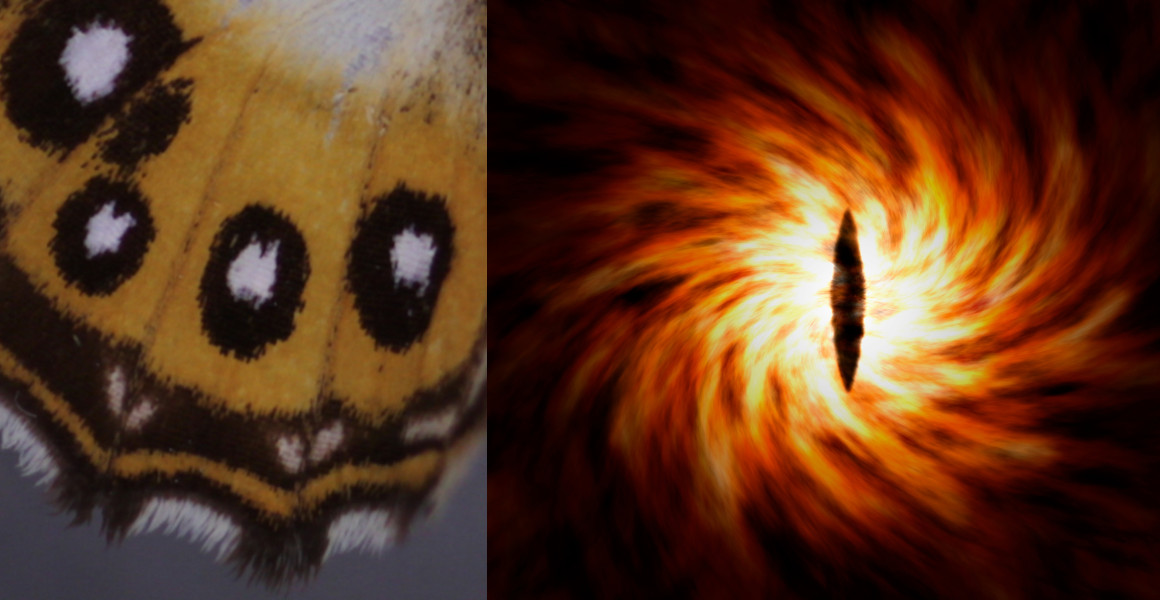Scientists have paid homage to an eye-conic villain from the Lord of the Rings in the name of a group of butterflies.
While there are currently only two members of the genus Saurona, many more as-yet-undescribed species are thought to exist.

The sharp contrast of the Saurona butterflies eyespots reminded researchers of the Lord of the Rings character. Butterfly image © The Trustees of the Natural History Museum, London and eye image © Cesare Andrea Ferrari/Shutterstock.
Scientists have paid homage to an eye-conic villain from the Lord of the Rings in the name of a group of butterflies.
While there are currently only two members of the genus Saurona, many more as-yet-undescribed species are thought to exist.
One of fiction's greatest villains is making their mark on the real world.
The Eye of Sauron is a well-known symbol from the Lord of the Rings, and was famously depicted on screen as a fiery orange eye peering over the landscape of Middle Earth.
So when a group of butterflies with bright orange hindwings and dark eyespots needed redescribing, researchers wasted no time in honouring the work of J.R.R. Tolkien in the name of a new genus.
Saurona is one of several new butterfly genera described by an international team of researchers in a new paper, and one of two named by Dr Blanca Huertas, the Senior Curator of Butterflies at the Museum.
'Giving these butterflies an unusual name helps to draw attention to this underappreciated group,' Blanca says. 'It shows that, even among a group of very similar-looking species, you can find beauty among the dullness.'
'Naming a genus is not something that happens very often, and it's even more rare to be able to name two at once. It was a great privilege to do so, and now means that we can start describing new species that we have uncovered as a result of this research.'
The study was published in the journal Systematic Entomology.

Euptychiina butterflies all share a relatively similar appearance, such as brown wings, which has made them hard for scientists to distinguish. Image © The Trustees of the Natural History Museum, London.
While Saurona triangula and Saurona aurigera are the first butterflies named after Sauron, they're not the only ones to bear the character's name. A dung beetle, a frog and even a dinosaur have been named after the villain, generally in reference to his eponymous eye.
These are but a few of the many species named after J.R.R Tolkien and his work. The wizard Gandalf, for instance, has a group of fossil mammals and species of crab, moth and beetle named after him, while Gollum gives his name to snails, wasps and a fish.
Though naming animals after a fictional character may seem spurious, it can be an important way of drawing attention to them. For instance, three Australian beetles were named after legendary Pokémon in an effort to attract conservation funding to species devastated by the 2019/20 wildfires.
In the case of the Saurona butterflies, giving them a pop culture epithet might help to draw public interest. While butterflies as a whole are one of the world's best studied group of insects, research tends to focus on the most distinctive and colourful.
For butterflies in a group known as the Euptychiina, teasing the species apart has remained a challenge. Physical traits which are normally used to tell butterflies apart, such as their wing colouration and patterns, often overlap between different species.
'These butterflies are widely distributed in the tropical lowlands of the Americas, but despite their abundance they weren't well-studied,' Blanca explains. 'Historically, the Euptychiina have been overlooked because they tend to be small, brown, and share a similar appearance.'
'This has made them one of the most complex groups of butterflies in the tropics of the Americas.'

The Museum's butterfly collections were used to help describe the new Euptychiina genera. Image © The Trustees of the Natural History Museum, London.
Advances in DNA sequencing mean that researchers are now able to identify species not only by their appearance, but also by their genetics. Techniques such as target enrichment and Sanger sequencing allowed the team to produce vast amounts of DNA from samples which could then be analysed.
Even then, studying the whole of the Euptychiina took over a decade as the team assessed more than 400 different species. For this, the Museum's butterfly collections of more than 5.5 million butterfly specimens was invaluable.
'The Museum's collections were key to describing the relationships of the Euptychiina,' Blanca says. 'The majority of the type specimens, which represent the species, are in the collections and it wouldn't have been possible without them.'
In the end, the researchers deciphered the relations between groups and described nine new genera, including Argenteria. This translates into English as silver mine, and was named by Blanca and a collaborator because of the silver scales on the wings.
There are currently six species in this genus, but there are likely to be many more. In total, the researchers estimate they uncovered up to 20% more species than there were before the project, and they are hoping to describe even more in the coming years.
Doing so will allow scientists to better understand the relationships between different species, as well as the issues which face them.
'It's important to study groups like the Euptychiina because it reveals that there are many species we didn't know about, including rare and endemic ones.' Blanca says. 'Some of these species are threatened with extinction, and so there's a lot to do now we can put a name to them.'
'There are also many other butterfly and insect groups that need attention so that they can be better understood and protected.'

We're working towards a future where both people and the planet thrive.
Hear from scientists studying human impact and change in the natural world.
Don't miss a thing
Receive email updates about our news, science, exhibitions, events, products, services and fundraising activities. We may occasionally include third-party content from our corporate partners and other museums. We will not share your personal details with these third parties. You must be over the age of 13. Privacy notice.
Follow us on social media